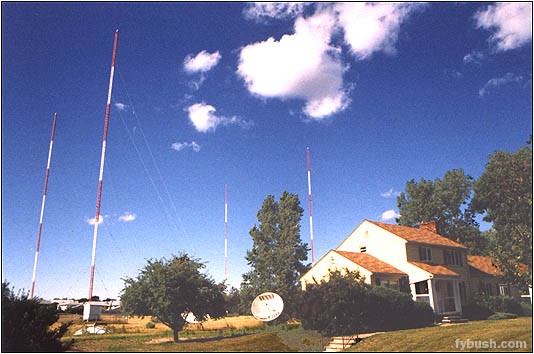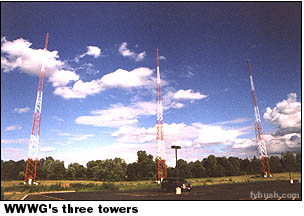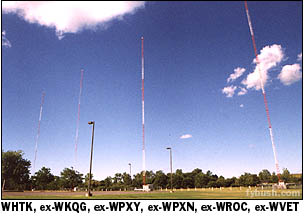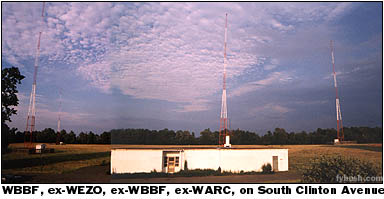
|
|
FYBUSH.COM/SITE OF THE WEEK
NEEDS YOUR SUPPORT! (AND YOU CAN GET A FREE TOWER SITE CALENDAR
IF YOU PLEDGE NOW...) CLICK HERE
TO LEARN MORE...
July 2-9, 2004
Brighton AM Sites, Rochester, N.Y.
Another encore presentation this week while we're on the road gathering new material; this week, it's the site originally presented here on December 27, 2000. In the intervening years, the WXXI site has taken on new meaning for your editor, who's now a part-time newsperson on AM 1370, broadcasting almost every day from these towers.
Presenting these towers this week is no coincidence. It was on July 2, 1984 that WXXI signed on at 1370. Happy 20th anniversary!

It seems only appropriate, somehow, that I begin the new millennium with a set of towers very close to my heart -- in fact, the very first towers I was ever aware of.
Shown above are the four towers of WXXI (1370) Rochester, located on French Road in the town of Brighton. Look very carefully behind the towers and you'll see an apartment complex, the one in which I spent the first three years of my life. Just to the right of this picture is my old middle school. About a mile to the north are the three sticks of WWWG (1460), whose beacons lulled me to sleep every night in the house where I lived as a child, just across the expressway from the tower site. And, oh yes, my elementary school's playground backed up to the 1460 towers. Is it any wonder I ended up like this?
 But
enough personal history: The 1370 site shown above was, I believe,
the first AM facility to locate in what was then rural farm country
along the Erie Canal in the 1940s. Of course, back then it was
WSAY, owned by eccentric inventor and broadcaster Gordon Brown
and operating from studios downtown. WSAY had been on the air
since 1936, using the graveyard frequencies of 1210 and later
1240 kHz. Its transmitter was somewhere closer to the city; I
wish I knew precisely where.
But
enough personal history: The 1370 site shown above was, I believe,
the first AM facility to locate in what was then rural farm country
along the Erie Canal in the 1940s. Of course, back then it was
WSAY, owned by eccentric inventor and broadcaster Gordon Brown
and operating from studios downtown. WSAY had been on the air
since 1936, using the graveyard frequencies of 1210 and later
1240 kHz. Its transmitter was somewhere closer to the city; I
wish I knew precisely where.
Brown won authorization in 1944 to move WSAY from 1240 and 250 watts to 1370 and 5 kilowatts, but it would take several years and the end of the war for the materials to be available to build this site. Sometime around 1946, these four towers went up and the era of AM radio in Brighton began. In the seventies, WSAY's studios moved to the transmitter building at 560 French Road (cleverly camouflaged as a house). When I first began visiting the facility in the early eighties, WSAY had given way to satellite talk, then country, as WRTK, still with studios in the French Road building.
In 1984, public broadcaster WXXI bought AM 1370, and the studio and newsroom became home to a noncommercial news, talk, and jazz format. Renovations to WXXI's downtown studios a few years later made room for the AM station there, and the French Road building briefly became home to Brighton Volunteer Ambulance. After a few years, the ambulance folks moved to their own building at Winton and Westfall, and the French Road studios were reclaimed by WXXI, this time to house the Rochester Radio Reading Service (later Reach-Out Radio) that operates on the WXXI-FM subcarrier. Your editor spent some time there in 1989 and 1990, reading the local section of the Democrat and Chronicle (and admiring the old transmitter in the hallway!). Reach-Out also moved downtown when the expanded WXXI building was completed in the mid-nineties, and since then only the 1370 transmitter has occupied the building on French Road.
Two more notes about this site: In the mid-nineties, WXXI engineers raised one of the four towers off its base and moved it slightly out of the square array, thus allowing a slight expansion of the night pattern to better reach listeners in the growing suburbs south and west of Rochester, none of which existed when these sites were built in the forties. During the tower work, WXXI used 1500 watts non-directional at night. WXXI owns land in the town of Mendon, at the southern edge of Monroe County, that could someday become home to the 1370 site if funding and NIMBY issues can be solved. Were this to happen, it would not only ease WXXI's problems in reaching listeners in the outer suburbs, but also eliminate the audio bleed that always seemed to plague cheap radios and TVs in my house nearby!
 Back
to our history: Next up, in 1947, was Rochester's second-oldest
AM. WHEC (1460) had been operating with 1000 watts non-directional
from a tower at 979 Mount Read Boulevard, on Rochester's west
side. The switch to a directional night signal, requiring protection
to Albany's WOKO, forced a move to the south of the city, and
the construction of three towers at 1850 South Winton Road. WHEC,
the flagship radio station of the Gannett newspaper chain, built
a virtual replica of the Art Deco transmitter building that had
been on Mount Read (and still stands there, painted blue and
used as the front entrance of a trucking company). The new building
remained in use as the AM 1460 transmitter site when Gannett
sold WHEC in 1972 and the station became rocker WAXC. After seven
years, WAXC gave way to WWWG, "3WG," in the late seventies,
and by the mid-eighties the 1460 studios had moved from downtown
Rochester to the transmitter site. Somewhere in the NERW archives
are some black-and-white pictures I took in the old building
around 1985, including the old transmitter behind glass doors
in the station lobby. If I ever find them, they'll be a future
Site of the Week.
Back
to our history: Next up, in 1947, was Rochester's second-oldest
AM. WHEC (1460) had been operating with 1000 watts non-directional
from a tower at 979 Mount Read Boulevard, on Rochester's west
side. The switch to a directional night signal, requiring protection
to Albany's WOKO, forced a move to the south of the city, and
the construction of three towers at 1850 South Winton Road. WHEC,
the flagship radio station of the Gannett newspaper chain, built
a virtual replica of the Art Deco transmitter building that had
been on Mount Read (and still stands there, painted blue and
used as the front entrance of a trucking company). The new building
remained in use as the AM 1460 transmitter site when Gannett
sold WHEC in 1972 and the station became rocker WAXC. After seven
years, WAXC gave way to WWWG, "3WG," in the late seventies,
and by the mid-eighties the 1460 studios had moved from downtown
Rochester to the transmitter site. Somewhere in the NERW archives
are some black-and-white pictures I took in the old building
around 1985, including the old transmitter behind glass doors
in the station lobby. If I ever find them, they'll be a future
Site of the Week.
By the start of the nineties, the pressures of development were being felt around the 1460 site. The Route 47 expressway was built alongside the property in the 1960s, and in 1980 became part of the Outer Loop (I-590/I-390), opening Winton Road to the spread of office parks. The land around WWWG was sold, the Art Deco 1947 building was razed, and the station was relocated into a small building that became part of an office park occupying most of the original WHEC property. The view above would have required a slog through the swamp behind the old building in 1985; by the time I took it in 1998, the parking lot extended to within a few feet of the towers. (WWWG's signal has never seemed the same since the construction; speculation suggests that the ground system was disrupted and never replaced, and I wouldn't disagree.)
 Drive
south from the WWWG towers on Winton Road, and you'll begin to
rise as the bridge crosses the Erie Canal. Slow down at the top,
and you'll see four sites at once: 1460 behind you, 1370 to your
left, WBBF 950 to your right (more on it in a moment), and just
ahead of you, four slim towers rising just to the south of the
canal.
Drive
south from the WWWG towers on Winton Road, and you'll begin to
rise as the bridge crosses the Erie Canal. Slow down at the top,
and you'll see four sites at once: 1460 behind you, 1370 to your
left, WBBF 950 to your right (more on it in a moment), and just
ahead of you, four slim towers rising just to the south of the
canal.
These belong to WHTK 1280, which began its life in Rochester in 1947 as WVET. At the time, these four towers were located a mile or so to the north, at 1343 Westfall Road, along the canal just east of the 950 towers. Legend has it that a dispute with the land's owner, farmer Max Gonsenhauser, led to WVET packing up its transmitter and moving the sticks to the present site on Winton just north of Brighton-Henrietta Town Line Road, where they've remained through many call letters since.
Your editor remembers this site from the early 80s, when the calls on the little brick transmitter building were "WPXN" and the only neighbor along the dirt road that sloped down from Winton towards the canal was a hunting club. In the nineties, the land just south and west of the 1280 towers was developed into the Canal View Office Park (a local radio wag called it the "Tower View Office Park"), and today office buildings abut the site within a few dozen feet. The view above was taken from the west side of the array in one of those new parking lots. The transmitter building, out of sight to the right of this photo, no longer has calls on it - we remember "WPXN" changing to "WPXY" but suspect the owners gave up as the calls changed again and again and again in the nineties.
 Turn
right from Winton to Town Line, then right again on Clinton,
and you'll find yourself at the fourth Brighton AM site. When
WARC set up shop here in 1947, it was the middle of nowhere.
The building in front of these four self-supporting towers (yes,
four - look carefully at the rear of the site just to the right
of the leftmost tower!) was the AM 950 studio for some years
as the station became WBBF and a major top-40 voice. As WBBF's
top-40 days were coming to a close in 1980, thousands of Rochesterians
were getting a much closer view of these towers with the opening
of the 390/590 interchange, which brought drivers looping around
the site as they drove from 590 south to 390 or vice versa. WBBF
briefly became WEZO from 1998 until 2000, though your editor
was never able to stop thinking of this as the "WBBF site"
and was thus relieved when the heritage calls were restored.
Turn
right from Winton to Town Line, then right again on Clinton,
and you'll find yourself at the fourth Brighton AM site. When
WARC set up shop here in 1947, it was the middle of nowhere.
The building in front of these four self-supporting towers (yes,
four - look carefully at the rear of the site just to the right
of the leftmost tower!) was the AM 950 studio for some years
as the station became WBBF and a major top-40 voice. As WBBF's
top-40 days were coming to a close in 1980, thousands of Rochesterians
were getting a much closer view of these towers with the opening
of the 390/590 interchange, which brought drivers looping around
the site as they drove from 590 south to 390 or vice versa. WBBF
briefly became WEZO from 1998 until 2000, though your editor
was never able to stop thinking of this as the "WBBF site"
and was thus relieved when the heritage calls were restored.
In a sense, all four of these sites are anachronisms. Designed to provide night coverage of the city of Rochester (about six miles to the north, if you're heading for downtown) and the inner suburbs that existed in the late forties, they're now limited by the nulls that protect stations to the east and west at night. In 950's case, it's Detroit and Utica (and 950 is further handicapped by being only 1 kilowatt and directional by day as well); in 1280's case, New York City; in 1370's, Manchester, N.H. and Toledo; and in 1460's, it's Albany and Columbus, Ohio. (Here's a pointless thought: Until the WADO 1280 towers were replaced last year, all three of the directional arrays along Winton Road protected stations using Blaw-Knox diamond towers; WADO on 1280, WFEA on 1370, and WBNS on 1460...)
Those night patterns now cut out potential listeners in places like Victor, Rush, and Chili, where only the big non-directional 50 kW of WHAM really punches through after dark. Anyway, most listeners are no longer glued to the signals from these sticks, tuning instead to the FM stations that emanate from places like Pinnacle Hill, just a couple of miles north of these sites and easily visible from the WBBF and WWWG arrays. (Want to see Pinnacle and all four AMs at once? It's easy to do along Westfall Road, between Clinton and Winton.)
Someday, it's possible to imagine that some of these sites won't even exist, should WXXI carry out its move to Mendon and WWWG lose the lease on its towers. If that day ever comes to pass, it'll be a mixed blessing here in NERW-land. On the one hand, it would be sad to lose the very first towers your editor was ever aware of. On the other hand, these arrays are still very much part of life here at NERW Central -- just two miles north of our old home base, and blasted all night long by the main lobes of each of these four AM signals! It would be awfully nice, we suppose, to be able to DX anything else between 1250 and 1480...
Still haven't ordered? It's not too late - Tower Site Calendar 2004 is STILL AVAILABLE! If you haven't yet ordered, what are you waiting for? Click here for ordering information!
- Previous Site of the Week: WCTM, Eaton OH
- Next Week: The Prudential Tower, Boston
- Site of the Week INDEX!
- How can you help support Site of the Week? Click here!
- Submit your suggestions for a future Site of the Week!
